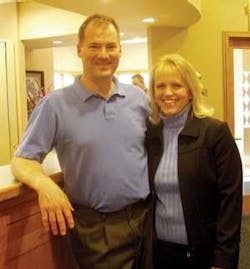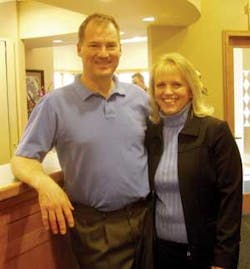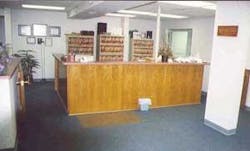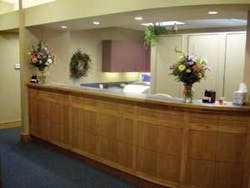An overnight success
By Jeff Carter, DDS
In the fall of 2005, Dr. Thomas Schmanski of Brookings, S.D., completed the best production month of his career. Tom, his wife Kris, and the Yorkshire dental team had just produced numbers that would easily place them in the top 5 percent of general practices in the country in terms of practice success. Production numbers were 300 percent higher than they were just a few years ago. Eighty-two new patients for this terrific month helped ensure their achievements would not be short-lived.
I first met Tommy Schmanski in November of 1968. He and his family had just moved from Anoka, Minn., to Fort Lupton, Colo. Fort Lupton was a blue-collar agricultural community of approximately 2,000 people. It was a chaotic time and the cultural strife of the late 1960s was evident. Unlike today, fighting and threatening people (now called felony assault and intent to commit bodily injury) was common and, unless someone was killed, most people looked the other way. I was three years older than Tommy, but had an immediate connection with him - we both suffered from what is now described as constitutional delayed growth syndrome. For all of intermediate school, junior high school, and most of high school, we were the shortest, smallest, and skinniest kids in our entire grade. It was great for making the lowest weight category on the wrestling team, but otherwise not the best time to be runts.
Tommy had four sisters and two brothers. Bernie and Terry Schmanski and their seven children shared a 730-square-foot, one-bathroom apartment above the Schmanski Funeral Home. While waiting for his turn to use the one bathroom, Tommy had ample time to reflect upon his parents’ passion to raise seven children and become successful small business entrepreneurs. Rather than deal with Bernie at the dinner table, all seven Schmanski children were straight-A students with few exceptions. It was difficult for the Schmanski kids to craft acceptable performance excuses to a dad who played defensive back for the University of Minnesota football team at 5-foot-1 and 140 pounds (by the way, both Tommy and his dad Bernie grew more than 10 inches in height during their college years).
null
The academic excellence did not stop for the seven Schmanski kids at the end of high school. Tommy, the second oldest, graduated from Creighton Dental School in 1982. His older sister Jeanne earned a bachelor’s and master’s degree in nursing. Mary received a bachelor’s degree in engineering from the United States Air Force Academy and was one of the first women to earn that distinction. Bob received a bachelor’s degree in engineering. Janet became another DDS graduate from Creighton. Susan followed in Jeanne’s footsteps with a bachelor’s and master’s degree in nursing, and Bill earned his bachelor’s and master’s degree in engineering. At a time when many of us struggle to get one or two kids through college, Bernie and Terry Schmanski made it possible for all seven children to graduate with college and/or advanced college degrees - an incredible feat by anyone’s standards.
Upon graduation, Tommy moved to Brookings, S.D., to set up his first practice. The early 1980s were not the best time to start a dental practice and the DDS “shingle” was no guarantor of small business success. With interest rates hovering around 18 percent, Tommy’s accountant advised him to file bankruptcy after a year or so in practice and get a fresh start somewhere more promising. Even though closing his current practice was probably a logical business decision, Tommy refused to renege on his financial obligations and would not walk away. The rest of the 1980s was a struggle and Tommy finished out the decade driving the same old 1956 four-door Chevy sedan he had driven since 1974.
In 1992, Tommy bought a pair of Orascoptic loupes that he considers his first profound equipment purchase. The heightened visual acuity gave him a new perspective on what it meant to practice dentistry and be a dentist. Dentistry was truly a “practice” and a lifelong journey if you were to do it right. Tommy was slowly growing his dental practice applying the same patience and principles his parents exhibited two decades earlier with their fledgling business. Reinvesting in his growing practice and gambling on future technology development, Tommy also purchased a $12,000 front desk computer in 1992. Tommy credits his first computer with enabling him to sort through the other developing technologies into useful and not useful categories.
In 1999, Tommy purchased the CEREC 2 after seeing the unit in a friend’s office. The CEREC purchase was in part due to Tommy’s search for satisfactory restorations for his own dentition. Offers of pin-amalgam build-ups and full crowns did not appeal to Tommy (or his mouth) as did the more conservative and esthetic CEREC restoration possibilities. In my opinion, it took real guts and foresight to purchase a $100,000 CEREC unit in 1999. Today’s CEREC 3-D is so much more user-friendly than the older units. Since 1999, Tommy has performed more than 4,000 CEREC restorations and the use of this unit is now a standard part of the practice day. In that same year - and for about $97,300 less than the CEREC - he also purchased a KaVo Diagnodent and experienced an immediate percentage increase in caries detected on new and existing patients. Patients reported the Diagnodent technology helped assuage their concerns to the validity of the caries diagnosis.
null
After practicing for more than 15 years and attending many continuing-education courses by the profession’s top clinicians, Tommy’s clinical skills had developed beyond his ability to “sell” cutting-edge dentistry to new and existing patients. After much analysis, he came to the conclusion that the current office and staff did not allow his patients to “see” the benefits of cutting-edge dentistry, no matter how it was presented. To make matters more stressful, his current lease space had multiple leaky pipes, frequent electrical problems, and an unsympathetic landlord. Tommy was convinced that the success or failure of a dental practice in the 21st century was much more dependent on the quality of the practice facility than in earlier times.
In late 2002, a pipe in Tommy’s office broke for the second time, leading to three missed practice days. That was enough for Tommy. If he was to continue practicing dentistry, he was going to do it his way and in his own state-of-the-art facility. As he had done with all other issues in his practice, he sought out consultants with expertise. What he did not anticipate was the office design consultant name he happened to stumble across in an article was also a former runt turned dentist from Fort Lupton, Colo. We had not seen nor spoken to each other in more than 20 years. We reunited at a dental office design course in Phoenix.
In another gutsy move, Tommy designed a six-operatory, 3,000-square-foot, free-standing dental facility. He felt this project scope was appropriate for his practice direction. Design is just one phase of completing a new facility as Tommy will now tell you. Financing and construction issues are often equally (if not more) challenging. The design phase of his new facility was completed in the spring of 2003. Unfortunately, the lenders available to Tommy did not share his enthusiasm for a new facility, despite early assurances his project was viable when measured against the typical practice management parameters. After months of negotiations and many doubtful moments as to whether this new facility was ever going to happen, construction pricing and financing were finally in place. Bernie and Terry Schmanski joined in with dental consultants to advise and support Tommy throughout this time and play integral parts in the process. Tommy’s new facility was finally completed in March of 2004, nearly five years after his revelation that the old facility had stymied any future practice growth.
For those of you considering a new facility, it is one aspect of a successful practice and not a cure all for all your practice ills. In the first year of practice in his new facility, Tommy experienced a total staff turnover. Much like the old facility, his former staff did not project Tommy’s vision of dentistry. Some staff members can struggle in the transition from the typical dental office to a state-of-the-art, esthetic, 21st-century dental facility. The heightened professional atmosphere attracts a more upscale patient base demanding cutting-edge comprehensive services. Unfortunately, certain personality types do not feel comfortable in this new environment and they may choose to quit or underperform, leading to termination.
A major disappointment to Tommy was the necessary delay in purchasing and installing the operatory portion of his new facility’s integrated technology design. The structure of his lending package did not allow the additional debt service to be incurred at the time of construction completion. Seventeen months after opening his new facility, Erickson Technologies completed the vision Tommy had to continue his lifelong journey in dentistry. The Erickson Technologies installation included six fully computerized operatories with dual monitor systems, three Digital Doc Evolution C-Series intraoral cameras, EagleSoft software, Orasphere patient education software, new printers, and a new upgraded server.
In the fall of 2005, Dr. Thomas Schmanski had the most productive month of his career and appeared to be an “overnight sensation” to the 82 new patients walking into his office for the first time.
Dr. Jeff Carter is co-owner of the Practice Design Group, based in Austin, Texas. PDG specializes in providing architectural, interior design and equipment, and technology integration services to dentists nationwide. Dr. Carter may be contacted by phone at (512) 295-2224, by e-mail at [email protected], or by visiting PDG’s Web site at www.practicedesigngroup.com.







